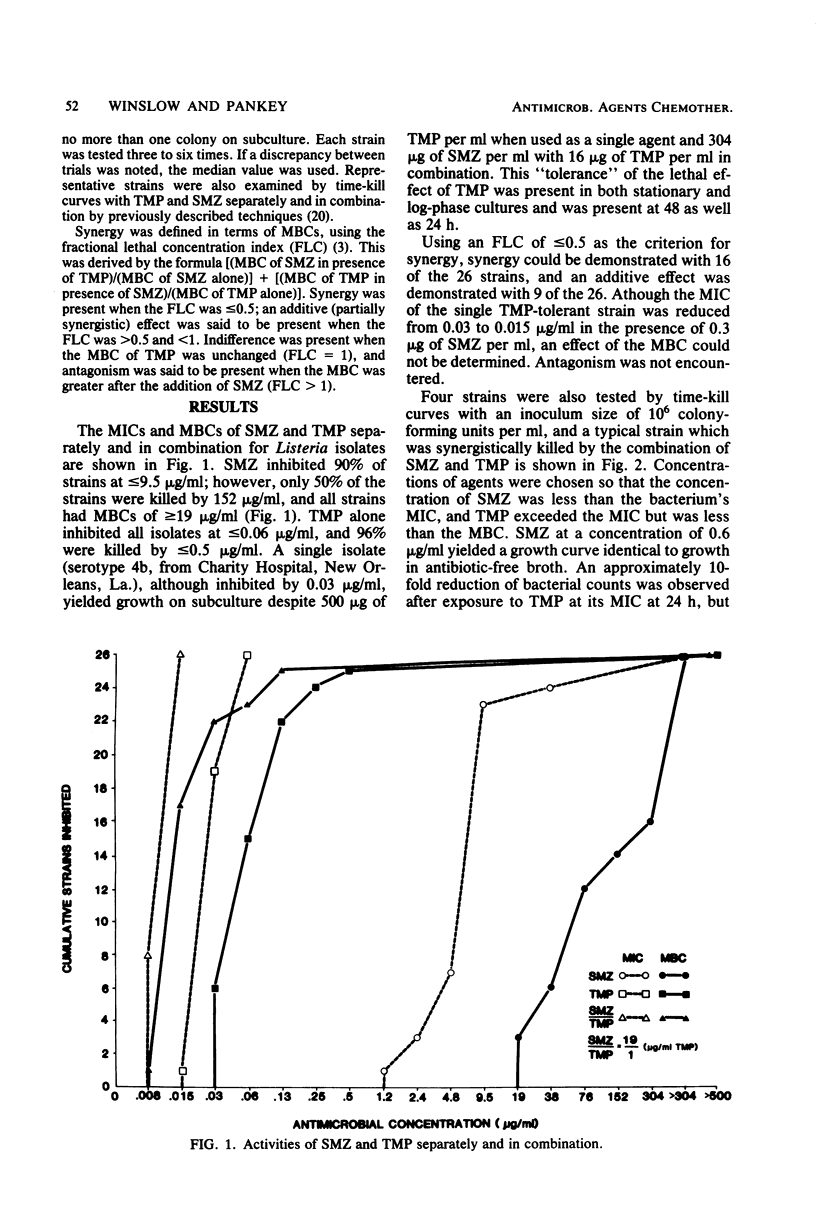Abstract
The in vitro activities of trimethoprim and sulfamethoxyazole against clinical isolates of Listeria monocytogenes were examined separately and in combination with a microtiter broth dilution system. Sulfamethoxazole demonstrated variable activity and was generally bacteriostatic. Trimethoprim alone was bactericidal against 96% of isolates at less than 0.5 microgram/ml. The bactericidal action of trimethoprim against L. monocytogenes was generally potentiated by sulfamethoxyazole even when isolates were relatively resistant to sulfamethoxyazole alone.
Full text
PDF



Selected References
These references are in PubMed. This may not be the complete list of references from this article.
- Bach M. C., Finland M., Gold O., Wilcox C. Susceptibility of recently isolated pathogenic bacteria to trimethoprim and sulfamethoxazole separately and combined. J Infect Dis. 1973 Nov;128(Suppl):508–p. doi: 10.1093/infdis/128.supplement_3.s508. [DOI] [PubMed] [Google Scholar]
- Barling R. W., Selkon J. B. The penetration of antibiotics into cerebrospinal fluid and brain tissue. J Antimicrob Chemother. 1978 May;4(3):203–227. doi: 10.1093/jac/4.3.203. [DOI] [PubMed] [Google Scholar]
- Berenbaum M. C. A method for testing for synergy with any number of agents. J Infect Dis. 1978 Feb;137(2):122–130. doi: 10.1093/infdis/137.2.122. [DOI] [PubMed] [Google Scholar]
- Bushby S. R. Trimethoprim-sulfamethoxazole: in vitro microbiological aspects. J Infect Dis. 1973 Nov;128(Suppl):442–p. doi: 10.1093/infdis/128.supplement_3.s442. [DOI] [PubMed] [Google Scholar]
- Chernik N. L., Armstrong D., Posner J. B. Central nervous system infections in patients with cancer. Medicine (Baltimore) 1973 Nov;52(6):563–581. doi: 10.1097/00005792-197311000-00003. [DOI] [PubMed] [Google Scholar]
- Cova J. L., Propp R. P., Barron K. D. Quantitative relationships of the fourth complement component in human cerebrospinal fluid. J Lab Clin Med. 1977 Mar;89(3):615–621. [PubMed] [Google Scholar]
- Darby C. P. Treating Pseudomonas cepacia meningitis with trimethoprim-sulfamethoxazole. Am J Dis Child. 1976 Dec;130(12):1365–1366. doi: 10.1001/archpedi.1976.02120130071014. [DOI] [PubMed] [Google Scholar]
- Edmiston C. E., Jr, Gordon R. C. Evaluation of gentamicin and penicillin as a synergistic combination in experimental murine listeriosis. Antimicrob Agents Chemother. 1979 Dec;16(6):862–863. doi: 10.1128/aac.16.6.862. [DOI] [PMC free article] [PubMed] [Google Scholar]
- Farid Z., Girgis N. I., Yassin W. Letter: Trimethoprim-sulfamethoxazole and bacterial meningitis. Ann Intern Med. 1976 Jan;84(1):50–51. doi: 10.7326/0003-4819-84-1-50. [DOI] [PubMed] [Google Scholar]
- Gantz N. M., Myerowitz R. L., Medeiros A. A., Carrera G. F., Wilson R. E., O'Brien T. F. Listeroisis in immunosuppressed patients. A cluster of eight cases. Am J Med. 1975 May;58(5):637–643. doi: 10.1016/0002-9343(75)90499-4. [DOI] [PubMed] [Google Scholar]
- Geddes A. M., Ball A. P., Farrell I. D. Co-trimoxazole for the treatment of serious infections. J Antimicrob Chemother. 1979 Nov;5(B):221–230. doi: 10.1093/jac/5.supplement_b.221. [DOI] [PubMed] [Google Scholar]
- Gordon R. C., Barrett F. F., Clark D. J. Influence of several antibiotics, singly and in combination, on the growth of Listeria monocytogenes. J Pediatr. 1972 Apr;80(4):667–670. doi: 10.1016/s0022-3476(72)80072-6. [DOI] [PubMed] [Google Scholar]
- Gordon R. C., Barrett F. F., Yow M. D. Ampicillin treatment of listeriosis. J Pediatr. 1970 Dec;77(6):1067–1070. doi: 10.1016/s0022-3476(70)80098-1. [DOI] [PubMed] [Google Scholar]
- Iwarson S., Lidin-Janson G., Svensson R. Listeric meningitis in the non-compromised host. Infection. 1977;5(4):204–206. doi: 10.1007/BF01640780. [DOI] [PubMed] [Google Scholar]
- Lane F. C., Unanue E. R. Requirement of thymus (T) lymphocytes for resistance to listeriosis. J Exp Med. 1972 May 1;135(5):1104–1112. doi: 10.1084/jem.135.5.1104. [DOI] [PMC free article] [PubMed] [Google Scholar]
- Larsson S., Cronberg S., Winblad S. Clinical aspects on 64 cases of juvenile and adult listeriosis in Sweden. Acta Med Scand. 1978;204(6):503–508. doi: 10.1111/j.0954-6820.1978.tb08480.x. [DOI] [PubMed] [Google Scholar]
- Moellering R. C., Jr, Medoff G., Leech I., Wennersten C., Kunz L. J. Antibiotic synergism against Listeria monocytogenes. Antimicrob Agents Chemother. 1972 Jan;1(1):30–34. doi: 10.1128/aac.1.1.30. [DOI] [PMC free article] [PubMed] [Google Scholar]
- Nirmul G., Glabman S., Haimov M., Leiter E., Burrows L. Listeria monocytogenes meningitis during immunosuppression. N Engl J Med. 1971 Dec 2;285(23):1323–1323. doi: 10.1056/NEJM197112022852318. [DOI] [PubMed] [Google Scholar]
- Norrby R. A review of the penetration of antibiotics into CSF and its clinical significance. Scand J Infect Dis Suppl. 1978;(14):296–309. [PubMed] [Google Scholar]
- Rahal J. J., Jr, Simberkoff M. S. Bactericidal and bacteriostatic action of chloramphenicol against memingeal pathogens. Antimicrob Agents Chemother. 1979 Jul;16(1):13–18. doi: 10.1128/aac.16.1.13. [DOI] [PMC free article] [PubMed] [Google Scholar]
- Scheld W. M., Fletcher D. D., Fink F. N., Sande M. A. Response to therapy in an experimental rabbit model of meningitis due to Listeria monocytogenes. J Infect Dis. 1979 Sep;140(3):287–294. doi: 10.1093/infdis/140.3.287. [DOI] [PubMed] [Google Scholar]
- Shuman R. D., Smith C. R. Intrathecal gentamicin for refractory gram-positive meningitis. JAMA. 1978 Aug 4;240(5):469–471. [PubMed] [Google Scholar]
- Svedhem A., Iwarson S. Cerebrospinal fluid concentrations of trimethoprim during oral and parenteral treatment. J Antimicrob Chemother. 1979 Nov;5(6):717–720. doi: 10.1093/jac/5.6.717. [DOI] [PubMed] [Google Scholar]
- Watson G. W., Fuller T. J., Elms J., Kluge R. M. Listeria cerebritis: relapse of infection in renal transplant patients. Arch Intern Med. 1978 Jan;138(1):83–87. doi: 10.1001/archinte.138.1.83. [DOI] [PubMed] [Google Scholar]
- Whittle H. C., Greenwood B. M. Cerebrospinal fluid immunoglobulins and complement in meningococcal meningitis. J Clin Pathol. 1977 Aug;30(8):720–722. doi: 10.1136/jcp.30.8.720. [DOI] [PMC free article] [PubMed] [Google Scholar]
- Wiggins G. L., Albritton W. L., Feeley J. C. Antibiotic susceptibility of clinical isolates of Listeria monocytogenes. Antimicrob Agents Chemother. 1978 May;13(5):854–860. doi: 10.1128/aac.13.5.854. [DOI] [PMC free article] [PubMed] [Google Scholar]
- Wilkinson P. J., Reeves D. S. Tissue penetration of trimethoprim and sulphonamides. J Antimicrob Chemother. 1979 Nov;5(B):159–168. doi: 10.1093/jac/5.supplement_b.159. [DOI] [PubMed] [Google Scholar]
- Woolfrey B. F., Ramadei W. A., Quall C. O. Evaluation of a semiautomated micro-broth dilution system for determing minimum inhibitory concentrations of antimicrobics. Am J Clin Pathol. 1980 Mar;73(3):374–379. doi: 10.1093/ajcp/73.3.374. [DOI] [PubMed] [Google Scholar]
- Wormser G. P., Keusch G. T. Trimethoprim-sulfamethoxazole in the United States. Ann Intern Med. 1979 Sep;91(3):420–429. doi: 10.7326/0003-4819-91-3-420. [DOI] [PubMed] [Google Scholar]


